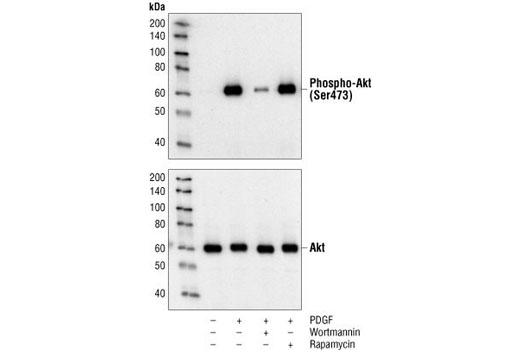
 DeepBio得分:
DeepBio得分:
 DeepBio得分
是基于文獻引用次數,影響因子,文獻新近度等因素計算的客觀產品評級,得分越高表明該產品經過越可靠的實驗驗證,質量可信度越高
DeepBio得分
是基于文獻引用次數,影響因子,文獻新近度等因素計算的客觀產品評級,得分越高表明該產品經過越可靠的實驗驗證,質量可信度越高
|
1家供應商在售
|
||||||
| 商品名稱 | 規(guī)格 | 代理級別 | 價格 | 運費 | 供應商 | 購買 |
|
CST 4058T Phospho-Akt(Ser473)(193H12) Rabbit mAb
交貨周期:部分現(xiàn)貨,期貨3-4周左右,優(yōu)質售后
|
20μl | 經銷 |
登錄可見
|
- |
上海優(yōu)寧維生物科技股份有限公司 |
庫存:998
|
| REACTIVITY | H M R |
| SENSITIVITY | Endogenous |
| MW (kDa) | 60 |
| Source/Isotype | Rabbit IgG |
| Application | Dilution |
|---|---|
| Western Blotting | 1:1000 |
| Immunoprecipitation | 1:200 |
| Immunofluorescence (Immunocytochemistry) | 1:200 |
| Flow Cytometry | 1:400 |
Supplied in 10 mM sodium HEPES (pH 7.5), 150 mM NaCl, 100 μg/ml BSA, 50% glycerol and less than 0.02% sodium azide. Store at –20°C. Do not aliquot the antibody.
Phospho-Akt (Ser473) (193H12) Rabbit mAb detects endogenous levels of Akt only when phosphorylated at Ser473.
Human, Mouse, Rat
Monoclonal antibody is produced by immunizing animals with a synthetic phosphopeptide corresponding to residues around Ser473 of mouse Akt.
Akt, also referred to as PKB or Rac, plays a critical role in controlling survival and apoptosis (1-3). This protein kinase is activated by insulin and various growth and survival factors to function in a wortmannin-sensitive pathway involving PI3 kinase (2,3). Akt is activated by phospholipid binding and activation loop phosphorylation at Thr308 by PDK1 (4) and by phosphorylation within the carboxy terminus at Ser473. The previously elusive PDK2 responsible for phosphorylation of Akt at Ser473 has been identified as mammalian target of rapamycin (mTOR) in a rapamycin-insensitive complex with rictor and Sin1 (5,6). Akt promotes cell survival by inhibiting apoptosis through phosphorylation and inactivation of several targets, including Bad (7), forkhead transcription factors (8), c-Raf (9), and caspase-9. PTEN phosphatase is a major negative regulator of the PI3 kinase/Akt signaling pathway (10). LY294002 is a specific PI3 kinase inhibitor (11). Another essential Akt function is the regulation of glycogen synthesis through phosphorylation and inactivation of GSK-3α and β (12,13). Akt may also play a role in insulin stimulation of glucose transport (12). In addition to its role in survival and glycogen synthesis, Akt is involved in cell cycle regulation by preventing GSK-3β-mediated phosphorylation and degradation of cyclin D1 (14) and by negatively regulating the cyclin dependent kinase inhibitors p27 Kip1 (15) and p21 Waf1/Cip1 (16). Akt also plays a critical role in cell growth by directly phosphorylating mTOR in a rapamycin-sensitive complex containing raptor (17). More importantly, Akt phosphorylates and inactivates tuberin (TSC2), an inhibitor of mTOR within the mTOR-raptor complex (18,19).
商城介紹 | 媒體報道 | 法規(guī)政策 | 協(xié)議專區(qū)
 京公網安備 11010802025067號 增值電信業(yè)務經營許可證:京B2-20171454 ICP備案號:京ICP備16050672號-1
喀斯瑪科技版權所有 2017-
京公網安備 11010802025067號 增值電信業(yè)務經營許可證:京B2-20171454 ICP備案號:京ICP備16050672號-1
喀斯瑪科技版權所有 2017-

![]() 藥品醫(yī)療器械網絡信息服務備案: (京)-網藥械信息備字(2022)第00393號
醫(yī)療器械網絡交易服務第三方平臺備案編號:京網械平臺備字(2021)第00006號
藥品醫(yī)療器械網絡信息服務備案: (京)-網藥械信息備字(2022)第00393號
醫(yī)療器械網絡交易服務第三方平臺備案編號:京網械平臺備字(2021)第00006號